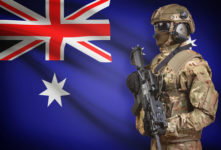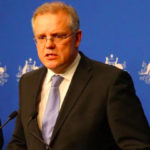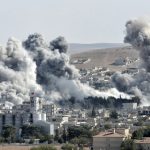Morrison to Send Australian Troops to the Persian Gulf

Scott Morrison claims to believe in a “fair go”. And last Wednesday, the prime minister announced that his government will give war a chance, as he ordered that troops be deployed to the Persian Gulf in support of the US, with actions specifically relating to Iran.
In a press release, the Pentecostal PM set out that Australian Defence Force troops will be working alongside “international partners” – so far, the US and the UK – to assure the security of oil tankers and cargo ships in the Strait of Hormuz.
Australia’s contribution to the “security mission” will consist of one P-8A Poseidon surveillance aircraft that will be sent in for a month this year, an Australian frigate to be sent in January for six months, and ADF personnel, who will be stationed at mission headquarters in Bahrain.
Without mentioning Iran, the release states that the “destabilising behaviour” that’s taking place in the waterway is “a threat to Australian interests in the region”. And the statement goes on to conclude that the mission is all about “shaping a better future for Australia”.
However, while the PM can dress up the agreement to join the US and the UK in the Gulf as a matter of “security and stability” all he wants, the truth is that Australia will be joining the Trump administration in its ongoing attempt to provoke the Republic of Iran into conflict.
An economic stranglehold
The Trump administration began taunting Iran on 8 May last year, when it announced it was pulling out of the 2015 Joint Comprehensive Plan of Action – or the Iran Nuclear Deal – and in its place it would be imposing debilitating sanctions on the Middle Eastern nation.
The result of the US sanctions, which kicked in on 4 November, is that the Iranian economy is now in free fall. Foreign investment has dried up and oil exports are in decline. Iranian foreign minister Java Zarif has described their imposition as “economic terrorism” on the part of the Americans.
False flags galore
In mid-June, dramatic images of an oil tanker on fire in the Gulf of Oman were doing the rounds of the internet. Indeed, on the 13th of that month two oil tankers – one Japanese and the other Norwegian – were mysteriously attacked in the region.
The US released footage it claimed was an Iranian patrol boat removing an unexploded limpet mine from one of the tankers. Although, the crews on both ships reported being hit by moving objects, like a torpedo, rather than stationary mines.
These attacks came a month after a similar incident took place in the Persian Gulf, just off the coast of the United Arab Emirates. Four tankers were bombed using limpet mines. And US allies Saudi Arabia, the UAE and Norway blamed it on a “state actor”, but didn’t name a specific nation.
Then on 20 June, Tehran shot down a US surveillance drone eight miles off its coast. Washington described the attack as “unprovoked”, whereas the Middle Eastern nation asserted that the high-altitude drone that took off in the UAE had gone on to violate its airspace.
And at that moment, Trump almost took aggressions to the next level. After Iran shot down the unmanned aircraft – responding to what it describes as an act of imperial provocation – Trump approved retaliation airstrikes, which were called off only minutes before commencing.
The sun never sets
Britain and Iran have been engaged in a game of tit for tat, which was sparked by London. On 4 July, British Royal Marines seized Iranian oil tanker Grace 1 off the coast of Gibraltar, claiming it was transporting oil to Syria in violation of European sanctions, which Iran is not a party to.
And Tehran subsequently seized the British-flagged oil tanker Stena Impero a fortnight later in the Strait of Hormuz, to which Britain responded by sending a second warship into the Gulf to ensure stronger protection for merchant shipping in the region.
Despite a push from the US to continue impounding the Iranian tanker, British authorities in Gibraltar released it early last week, stating there were no legal obstacles to prevent the ship from continuing on to its original destination, which had since been established as Kalamata in Greece.
Meanwhile, Sweden has announced that it’s received indications from Iran that it’s about to release the British oil tanker. Tehran originally claimed it seized the ship in retaliation for Grace 1, but has since asserted that the British vessel had violated maritime rules in the Gulf.
Missed opportunities?
Over the weekend, Scott Morrison was in France after having been invited along to the G7 summit. The PM had a closed door meeting with Donald Trump, where the two discussed Australia’s plan to join the US in patrolling the Persian Gulf.
And Morrison was as surprised as all the other world leaders, when the Iranian foreign minister flew in to join the summit for some unscheduled side meetings, in what appears to have been an attempt by French president Macron to ease the tensions between Washington and Tehran.
While the Iranian politician met with French and German officials, he flew out of the country without having met representatives from the US and the UK. And by Sunday evening, it was certain that Macron’s attempt to mend ties had failed.
A pretext to rail against
So, what we’re left with is Australia committing to what may develop into a similar conflict as those previously waged in Iraq and Afghanistan. Indeed, it seems Canberra is again prepared to follow Washington into a new Middle Eastern conflict in a country that poses no existential threat.
But, what’s not so clear is how the impetus to war will be framed. Just like those elusive weapons of mass destruction that led to the war in Iraq, Washington needs a new furphy that will drag its troops and those of its allies over the line into war.







